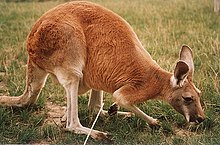Red kangaroo
| Red kangaroo Temporal range: 2–0 Ma Early – Recent |
|
|---|---|
 |
|
| Scientific classification | |
| Kingdom: | Animalia |
| Phylum: | Chordata |
| Class: | Mammalia |
| Infraclass: | Marsupialia |
| Order: | Diprotodontia |
| Family: | Macropodidae |
| Genus: | Macropus |
| Species: | M. rufus |
| Binomial name | |
|
Macropus rufus Desmarest, 1822 |
|
 |
|
The red kangaroo (Macropus rufus) is the largest of all kangaroos, the largest terrestrial mammal native to Australia, and the largest extant marsupial. It is found across mainland Australia, avoiding only the more fertile areas in the south, the east coast, and the northern rainforests.
This species is a very large kangaroo with long, pointed ears and a squared-off muzzle. Males have short, red-brown fur, fading to pale buff below and on the limbs. Females are smaller than males and are blue-grey with a brown tinge, pale gray below, although arid zone females are colored more like males. It has two forelimbs with small claws, two muscular hind-limbs, which are used for jumping, and a strong tail which is often used to create a tripod when standing upright. The red kangaroo's legs work much like a rubber band, with the Achilles tendon stretching as the animal comes down, then releasing its energy to propel the animal up and forward, enabling the characteristic bouncing locomotion. The males can cover 8–9 m (26.2–29.5 ft) in one leap while reaching heights of 1.8–3 m (5.9–9.8 ft), though the average is 1.2–1.9 m (3.9–6.2 ft)
Males grow up to a head-and-body length of 1.3–1.6 m (4.3–5.2 ft) with a tail that adds a further 1–1.2 m (3.3–3.9 ft) to the total length. Females are considerably smaller, with a head-and-body length of 85–105 cm (33–41 in) and tail length of 65–85 cm (26–33 in). Females can weigh from 18 to 40 kg (40 to 88 lb), while males typically weigh around twice as much at 55 to 90 kg (121 to 198 lb). The average red kangaroo stands approximately 1.5 m (4.9 ft) tall to the top of the head in upright posture. Large mature males can stand more than 1.8 m (5.9 ft) tall, with the largest confirmed one having been around 2.1 m (6.9 ft) tall and weighed 91 kg (201 lb).
The red kangaroo maintains its internal temperature at a point of homeostasis about 36 °C (97 °F) using a variety of physical, physiological, and behavioral adaptations. These include having an insulating layer of fur, being less active and staying in the shade when temperatures are high, panting, sweating, and licking its forelimbs.
The red kangaroo's range of vision is approximately 300° (324° with about 25° overlap), due to the position of its eyes.
The red kangaroo ranges throughout western and central Australia. Its range encompasses scrubland, grassland, and desert habitats. It typically inhabits open habitats with some trees for shade. Red kangaroos are capable of conserving enough water and selecting enough fresh vegetation to survive in an arid environment. The kangaroo’s kidneys efficiently concentrate urine, particularly during summer. Red kangaroo primarily eat green vegetation, particularly fresh grasses and forbs, and can get enough even when most plants look brown and dry. One study of kangaroos in Central Australia found that green grass makes up 75–95% of the diet, with Eragrostis setifolia dominating at 54%. This grass continues to be green into the dry season. Kangaroos also primarily consumed this species, along with Enneapogon avanaceus, in western New South Wales where they comprised much as 21–69% of its diet according to a study. During dry times, kangaroos search for green plants by staying on open grassland and near watercourses. While grasses and forbs are preferred, red kangaroos will also eat certain species of chenopods, like Bassia diacantha and Maireana pyramidata, and will even browse shrubs when its favoured foods are scarce. However, some perennial chenopods, such as round-leaf chenopod Kochia are avoided even when abundant.
...
Wikipedia

